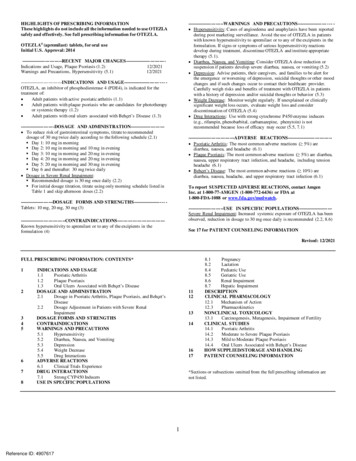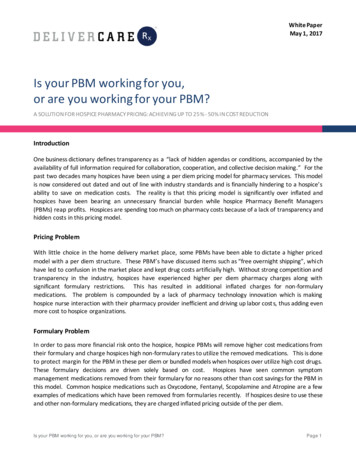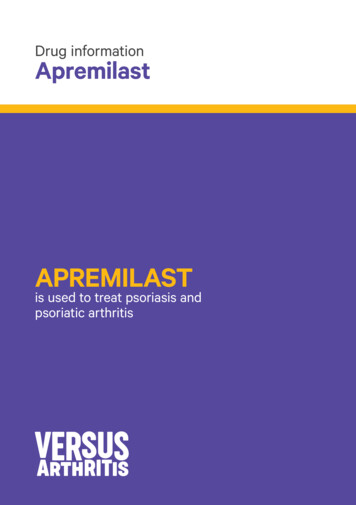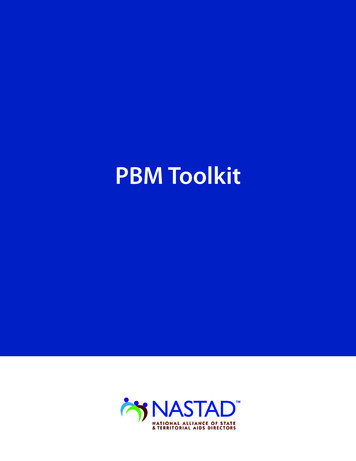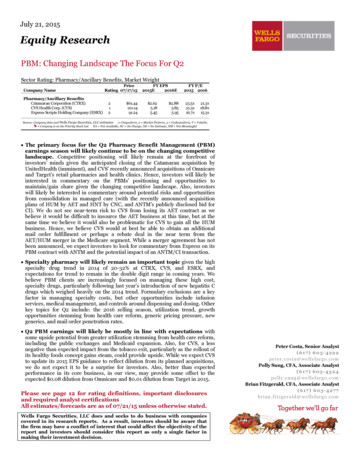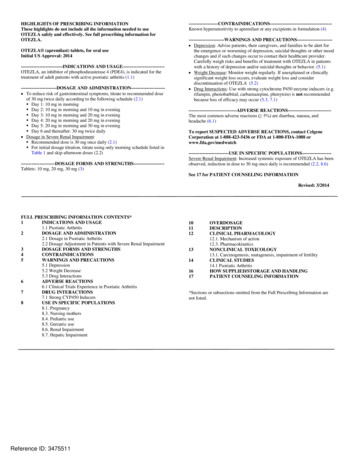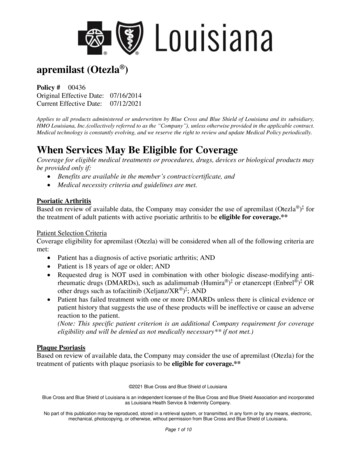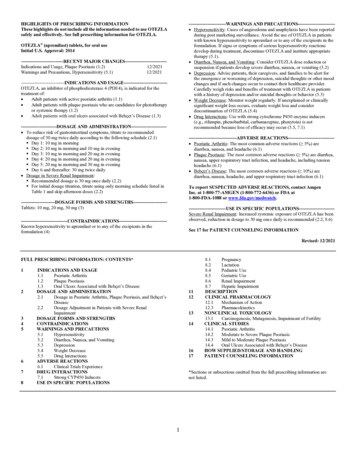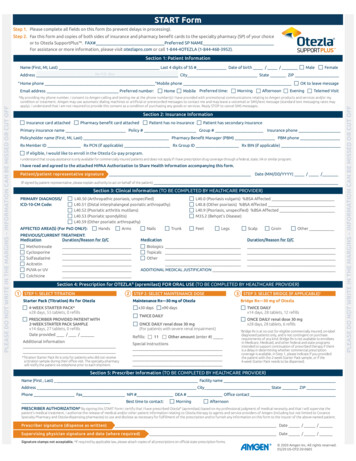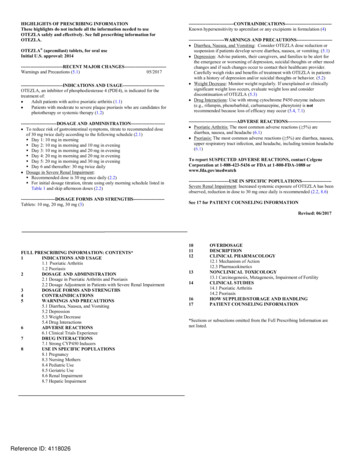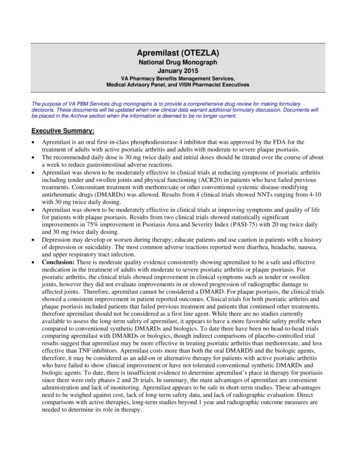
Transcription
Apremilast (OTEZLA)National Drug MonographJanuary 2015VA Pharmacy Benefits Management Services,Medical Advisory Panel, and VISN Pharmacist ExecutivesThe purpose of VA PBM Services drug monographs is to provide a comprehensive drug review for making formularydecisions. These documents will be updated when new clinical data warrant additional formulary discussion. Documents willbe placed in the Archive section when the information is deemed to be no longer current.Executive Summary: Apremilast is an oral first-in-class phosphodiesterase 4 inhibitor that was approved by the FDA for thetreatment of adults with active psoriatic arthritis and adults with moderate to severe plaque psoriasis.The recommended daily dose is 30 mg twice daily and initial doses should be titrated over the course of abouta week to reduce gastrointestinal adverse reactions.Apremilast was shown to be moderately effective in clinical trials at reducing symptoms of psoriatic arthritisincluding tender and swollen joints and physical functioning (ACR20) in patients who have failed previoustreatments. Concomitant treatment with methotrexate or other conventional systemic disease-modifyingantirheumatic drugs (DMARDs) was allowed. Results from 4 clinical trials showed NNTs ranging from 4-10with 30 mg twice daily dosing.Apremilast was shown to be moderately effective in clinical trials at improving symptoms and quality of lifefor patients with plaque psoriasis. Results from two clinical trials showed statistically significantimprovements in 75% improvement in Psoriasis Area and Severity Index (PASI-75) with 20 mg twice dailyand 30 mg twice daily dosing.Depression may develop or worsen during therapy; educate patients and use caution in patients with a historyof depression or suicidality. The most common adverse reactions reported were diarrhea, headache, nausea,and upper respiratory tract infection.Conclusion: There is moderate quality evidence consistently showing apremilast to be a safe and effectivemedication in the treatment of adults with moderate to severe psoriatic arthritis or plaque psoriasis. Forpsoriatic arthritis, the clinical trials showed improvement in clinical symptoms such as tender or swollenjoints, however they did not evaluate improvements in or slowed progression of radiographic damage toaffected joints. Therefore, apremilast cannot be considered a DMARD. For plaque psoriasis, the clinical trialsshowed a consistent improvement in patient reported outcomes. Clinical trials for both psoriatic arthritis andplaque psoriasis included patients that failed previous treatment and patients that continued other treatments,therefore apremilast should not be considered as a first line agent. While there are no studies currentlyavailable to assess the long-term safety of apremilast, it appears to have a more favorable safety profile whencompared to conventional synthetic DMARDs and biologics. To date there have been no head-to-head trialscomparing apremilast with DMARDs or biologics, though indirect comparisons of placebo-controlled trialresults suggest that apremilast may be more effective in treating psoriatic arthritis than methotrexate, and lesseffective than TNF inhibitors. Apremilast costs more than both the oral DMARDS and the biologic agents,therefore, it may be considered as an add-on or alternative therapy for patients with active psoriatic arthritiswho have failed to show clinical improvement or have not tolerated conventional synthetic DMARDs andbiologic agents. To date, there is insufficient evidence to determine apremilast’s place in therapy for psoriasissince there were only phases 2 and 2b trials. In summary, the main advantages of apremilast are convenientadministration and lack of monitoring. Apremilast appears to be safe in short-term studies. These advantagesneed to be weighed against cost, lack of long-term safety data, and lack of radiographic evaluation. Directcomparisons with active therapies, long-term studies beyond 1 year and radiographic outcome measures areneeded to determine its role in therapy.
Apremilast MonographIntroductionApremilast is the first drug in the phosphodiesterase 4 (PDE4) inhibitor drug class approved for the treatment ofpsoriatic arthritis and plaque psoriasis. It is also the first oral medication approved for treatment of adult patientswith active psoriatic arthritis since the commonly used disease modifying anti-rheumatic drugs (DMARDs) do notcarry an FDA approved indication for psoriatic arthritis. Apremilast cannot be considered a DMARD because theclinical trials to date have not addressed radiographic improvements in patients with psoriatic arthritis.The purposes of this monograph are to (1) evaluate the available evidence of safety, tolerability, efficacy, cost,and other pharmaceutical issues that would be relevant to evaluating apremilast for possible addition to the VANational Formulary; (2) define its role in therapy; and (3) identify parameters for its rational use in the VA.Pharmacology/PharmacokineticsMechanism of ActionApremilast inhibits PDE4, which results in increased intracellular cAMP levels in inflammatory cells. As a result,inhibition of PDE4 leads to a persistent elevation of cAMP and subsequently diminished T-cell secretion ofproinflammatory cytokines and other mediators, including TNF-alpha, IFN- , nitric oxide synthase, IL-2, IL-17,and IL-23. Through modulation of cAMP levels, PDE4 may regulate the proinflammatory actions of monocytes,T-cells, and neutrophils. Mesenchymal cells that express PDE4 include keratinocytes within the dermis, smoothmuscle, and vascular endothelium.2PharmacokineticsTable 1 Pharmacokinetics of ApremilastParameterDescriptionAbsorptionTmax: 2.5 hoursExtent of absorption not affected by foodMetabolismIn vitro, CYP 3A4 (major), CYP 1A2 and CYP 2A6 (minor)EliminationRenal excretion: 3% unchangedFecal excretion: 7% unchangedHalf-life6–9 hoursProtein Binding68%Bioavailability73%FDA-approved Indication(s)Apremilast is FDA-approved for the following indicationsi: Treatment of adult patients with active psoriatic arthritis.Treatment of patients with moderate to severe plaque psoriasis who are candidates for phototherapy orsystemic therapy.Potential Off-label Uses Ankylosing spondylitisoOne RCT compared apremilast 30 mg BID to placebo in 38 patients for 12 weeks.3 The primary endpoint,which was mean change in Bath Ankylosing Spondylitis Disease Activity Index (BASDAI) at week 12compared to baseline, was not significant. Further studies are needed to recommend apremilast for thisindication.Updated version may be found at www.pbm.va.gov or vaww.pbm.va.gov2
Apremilast Monograph Rosaceao Atopic dermatitiso One open-label pilot study compared apremilast 20 mg BID for a total of three months with apremilast 30mg BID for a total of six months in 16 patients.5 Overall, patients in both groups experienced significantreductions in pruritus VAS and Dermatology Life Quality Index (DLQI) compared to baseline. Furtherstudies are needed to recommend apremilast for this indication.Discoid lupus erythematosuso One open –label pilot study evaluated apremilast 20 mg twice daily in 12 patients for a total of 12 weeks.4Significant improvements compared to baseline were seen in the following secondary endpoints:Physician Global 7-Point Assessment, Patient Global Assessment (PGA), Physician Overall ErythemaSeverity, and physician-rated variable scales. Further studies are needed to recommend apremilast for thisindication.One phase 2, open-label, single-arm, pilot study evaluated apremilast 20 mg twice daily for 85 days in 8patients.6 The primary outcome was change in Cutaneous Lupus Erythematosus Disease Area andSeverity Index (CLASI) from baseline to day 85. Significant reduction in median CLASI scores wereseen. Further studies are needed to recommend apremilast for this indication.Lichen planusoOne open-label, non-randomized, pilot study evaluated apremilast 20 mg twice daily for 12 weeks in 10patients.7 Three of the ten patients achieved a 2-grade or more improvement in the PGA score comparedto baseline. Further studies are needed to recommend apremilast for this indication.Current VA National Formulary AlternativesOral conventional synthetic DMARDs on national formulary are the following: mulary AlternativesBiologic DMARDs are nonformulary. Key exclusion criteria for biologics include contraindication to biologic therapy, such as active or severe infectionor administration of live vaccine concomitantly with or during biologic therapy.Inclusion criteria for use of biologics are extensive and differ for each agent, but generally require patients to haveinadequate response, hypersensitivity, serious adverse event, or contraindication to methotrexate.Updated version may be found at www.pbm.va.gov or vaww.pbm.va.gov3
Apremilast MonographDosage and AdministrationFilm-coated tablet, oral: 30 mg twice daily is the recommended daily dose.A therapy pack with 10 mg, 20 mg, and 30 mg tablets is available for initial titration of therapy. Patients shouldreceive four doses of 10 mg tablets, followed by four doses of 20 mg tablets, and then 30 mg tablets thereafter.See package insert for detailed information.Administer without regard to food.Swallow tablets whole; do not crush, chew, or split.Dosage in Specific PopulationsRenal Impairment: For patients with CrCl 30 mL/min, the evening doses should be skipped during titration. Itis recommended that the daily dose should be reduced to 30 mg once daily. No specific recommendations forpatients on dialysis.Hepatic Impairment: No dosage adjustment necessary.StorageStore tablets below 30 C (86 F).EfficacyEfficacy MeasuresThe psoriatic arthritis (PsA) studies used 20% improvement in the modified American College of Rheumatologyresponse criteria (ACR20), which was developed to measure changes in rheumatoid arthritis symptoms and foundto be useful for discriminating treatment effects in PsA clinical trials. The ACR score is more commonly used inclinical trials than in doctor-patient relationships, as it allows a common standard between researchers.8 An ACRscore of 20 means that the patient’s symptoms have improved by 20%, an ACR score of 50% means the patient’ssymptoms have improved by 50%, etc. To qualify for an ACR20 score, a person must have at least 20% fewertender joints and at least 20% fewer swollen joints, as well as a 20% improvement in at least three of the fivefollowing areas: the person’s overall assessment of his or her own PsA, the physician’s global assessment of theperson’s PsA, the person’s assessment of his or her own pain, the person’s assessment of his or her own physicalfunctioning, and the results of an erythrocyte sedimentation rate or C-reactive protein blood test.9Health Assessment Questionnaire Disability Index (HAQ-DI) is one of the most widely used tools to addressfunctional capacity of patients with rheumatic diseases. It addresses the patient’s ability to perform any of 20activities in his or her daily life, with one of four responses available: without any difficulty (score 0), with somedifficulty (score 1), with much difficulty (score 2), and unable to do (score 3). The 20 activities are classified intoeight categories: dressing and grooming, arising, eating, walking, hygiene, reaching, gripping, and other activities,with two or three activities per category. A score is then assigned to each category based on the highest score forany activity within that category. The total HAQ-DI score is the mean of the representative scores for eachcategory.10The FDA states that the minimal clinically important difference (MCID) is a decrease 0.22 units.11The Short Form (36) Health Survey (SF-36) is a patient-reported survey of patient health. It can be used tomonitor and compare disease burden as well as other health aspects. It consists of eight scaled scores, which arethe weighted sums of the questions in their section. The eight sections are vitality, physical functioning, bodilypain, general health perceptions, physical role functioning, emotional role functioning, social role functioning,and mental health. Each scale is directly transformed into a 0-100 scale, assuming that each question carries equalweight. A lower score indicates greater disability.12Updated version may be found at www.pbm.va.gov or vaww.pbm.va.gov4
Apremilast MonographThe current gold standard for assessment of extensive psoriasis has been the Psoriasis Area and Severity Index(PASI). The PASI is a measure of the average redness, thickness, and scaliness of the lesions (each graded on a 0–4 scale), weighted by the area of involvement. A 75% improvement in PASI (PASI 75) is a well-establishedclinically meaningful endpoint for clinical trials, and there is strong evidence demonstrating that 50%improvement in PASI (PASI 50) is also a clinically meaningful endpoint.13The Psoriatic Arthritis Response Criteria (PsARC) assesses the following: (1) 20% or more improvement inphysician global assessment of disease activity; (2) 20% or more improvement in patient global assessment ofdisease activity; (3) 30% or more improvement in tender joint count; and (4) 30% or more improvement inswollen joint count. In order to achieve response, patient must meet at least two of the criteria and one of thecriteria met must be either a tender or swollen joint count. The patient also cannot have any worsening in any ofthe four criteria.14Summary of efficacy findingsPsoriatic ArthritisOne high-quality Phase 2 RCT,15 one high-quality Phase 3 RCT16 and two unpublished RCTs17,18 showedapremilast to be superior to placebo in the treatment of psoriatic arthritis, measured in percentage of patientsachieving ACR20 (Table 2).Table 2 ACR20 Responder Rates, Psoriatic Arthritis TrialsTimePoint (wk)APR 20 BID% (N)Schett, et15al.(2012)1243.5% (55)NNT 3 (2–7)Kavanaugh, et al.16(2014)1631.3% (163)NNT 9 (5–40)39.8% (161)NNT 5 (4–10)19.4% (165)Cutolo, et al.17(2013), abstract1638.4%NNT 534.4%NNT 719.5%Edwards, et al.18(2013), abstract1629.4%NNT 1042.8%NNT 418.9%ReferenceAPR 30 BID% (N)APR 40 QD% (N)PBO% (N)35.8% (60)NNT 4 (3–13)11.8% (50)All differences in rates between apremilast groups versus placebo groups were statistically significant (p 0.0235). NNT, Number needed totreat (95% CI).Overall, the results showed that apremilast had small to moderate effects in terms of ACR20 responder rates at 12or 16 weeks. Differences in diagnostic criteria and study populations (e.g., number of tender joints, CRPconcentrations, and percentages of patients on methotrexate) may explain the higher responder rates in the Schett(2012) trial15 relative to those in the Kavanaugh (2014)16 trial.A follow-on publication by Strand, Schett, et al. (2013)19 on the Phase 2 RCT (by Schett, et al. 2012)15 reportedthat apremilast was superior to placebo in terms of patient reported outcomes (PROs).19 For APR20 vs. APR40 vs.PBO:oooooMean change in Global VAS: -10.3 (p 0.05) vs. -10.4 (p 0.05) vs. 1.0 (MCID 10.0)Mean change in Pain VAS: -11.2 (p 0.05) vs. -11.5 (p 0.05) vs. -1.3 (MCID 10.0)Mean change in FACIT-F: 4.1 (p 0.05) vs. 4.3 (p 0.05) vs. 0.5 (MCID 4.0)Mean change in SF-36 MCS: 3.4 (p 0.05) vs. 1.1 vs. -0.8 (MCID 2.5)Mean change in SF-36 PCS: 2.4 (p 0.05) vs. 2.1 vs. 0.8 (MCID 2.5)Although these results were statistically significant, the expected clinical benefits would be minimal since allresults for apremilast were slightly above the MCID.Updated version may be found at www.pbm.va.gov or vaww.pbm.va.gov5
Apremilast MonographPlaque Psoriasis Two moderate quality RCT showed apremilast to be superior to placebo in the treatment of plaquepsoriasis.20,21oPapp, Cather, et al. (2012), Phase 2b RCT20: oPapp, Kaufmann, et al. (2013),.Phase 2 RCT21: oProportion of patients achieving PASI-75 at week 12: APR20 BID: 24.4% (p 0.023) vs.PBO : 10.3%Strand, Fiorentino, et al. (2013)22 reported patient-reported outcomes at Week 16 for the Phase 2b RCTauthored by Papp, Cather, et al. (2012)20: Percentage of patients achieving PASI-75 at week 16: APR 20 BID 29% of 87 patients,(OR 6.69; 95% CI 2.43-18.5; p 0.0001), APR 30 BID 41% of 88 patients (OR 11.5;4.24-31.16; p 0.0001) compared with PBO 6 % of 88 patientsAPR 10 BID results that did not significantly differ when compared with PBO are notpresented here.Mean percent change in DLQI: APR 20 BID: -5.9 (p 0.001), APR 30 BID: -4.4(p 0.005) PBO: -1.9 (MCID 5.0)Mean percent change in pruritus VAS: APR 20 BID: -35.5 (p 0.005) vs. APR 30BID: -43.7 (p 0.05) vs. PBO: -6.1 (MCID 10.0)Mean change in SF-36 MCS: APR 10 BID: 2.8 (p 0.008) vs. APR 20 BID: 3.3 (p 0.007)vs. APR 30 BID: 3.0 (p 0.005) vs. PBO -0.5 (MCID 2.5)APR 10 BID results that did not significantly differ when compared with PBO are notpresented here.Two unpublished, 52-week (including 16-week placebo-controlled phases), Phase 3 RCTs are ongoing underthe ESTEEM (Efficacy and Safety Trial Evaluating the Effects of apreMilast in psoriasis) clinical trialprogram. Study NCT01690299 will compare apremilast with etanercept for treatment of psoriasis.Table 3 Assessment of Evidence Base for Psoriatic ArthritisCategorySummaryOverall Quality of Studies (GRADE)GRADE: Moderate. Two studies were high quality. Two other studies wereunable to be rated because they were reported as abstracts.Consistency of ResultsThe 2 published studies showed a small to moderate benefit in reducingsigns and symptoms of psoriatic arthritis, with a NNT ranging from 4-10 forapremilast 30mg twice daily dosing.Directness of EvidenceThese studies showed a direct improvement in symptoms of psoriaticarthritis such as tender and swollen joints, however they did not evaluateradiographic improvement, which, long-term, is the more desired outcome.Precision of ResultsThe 95% CI around the between-group difference in achievement of anACR20 was fairly wide, indicating imprecision of results and some degreeof uncertainty in effect size. The widest 95% CI was 0.16-0.46 for15apremilast 20mg BID vs. placebo (Schett G, et al. 2012). The narrowest95% CI was 0.01-0.20 for apremilast 20mg BID vs. placebo (Edwards CJ,17et al. 2013, abstract).Updated version may be found at www.pbm.va.gov or vaww.pbm.va.gov6
Apremilast MonographTable 3 Assessment of Evidence Base for Plaque PsoriasisCategorySummaryOverall Quality of Studies (GRADE)GRADE: Moderate. Evidence available from two phase 2 trials.Consistency of ResultsBoth (2 of 2) studies showed a significant benefit in reducing signs andsymptoms of plaque psoriasis.Directness of EvidenceThese studies showed a direct improvement in symptoms of plaquepsoriasis, as well as an improvement in patient reported outcomes. Plaquepsoriasis is generally a cosmetic condition and can affect a patient’squality of life; therefore using patient reported outcomes is a direct methodfor addressing the efficacy of apremilast in this condition.Precision of ResultsThe 95% CI around the between-group difference in proportion of patientsachieving PASI-75 at week 16 was fairly wide, indicating imprecision ofresults and uncertainty in effect size. A 95% CI of 4.24-31.16 was foundfor an Odds Ratio of 11.5 when comparing apremilast 30mg BID toplacebo (Papp, Cather, et al. 2012).Indirect Efficacy Comparisons with Alternative TherapiesIn crude indirect comparisons using ACR20 responder rates from psoriatic arthritis placebo-controlled trials,apremilast (NNTs 4–10, Table 2) seems to be less efficacious than TNF inhibitors (NNTs 2–3) and similar toustekinumab (NNT 4) (Table 4).Table 4 ACR20 NNTs for Biologic Agents in Psoriatic ArthritisDuration ofTreatmentNNTPrevious failure of treatment with 1 DMARDs. At enrollment, patients wererequired to have active peripheral polyarticular arthritis, defined as the presence of 5 swollen and tender joints in conjunction with at least 1 of the following criteria:ESR 28 mm/hour, CRP level 15 mg/liter, and/or morning stiffness lasting 45minutes or longer. Patients also were required to have negative results of serumtests for rheumatoid factor.16 weeks2Active PsA diagnosed at least 6 months before the first infusion of study drug.Active articular disease was defined as 5 swollen joints and 5 tender joints andeither CRP 15 mg/l and/ or morning stiffness lasting 45 minutes or longer. Patientswere required to have had an inadequate response to current or previous DMARDsor NSAIDs. In addition, patients had to have active plaque psoriasis with at leastone qualifying target lesion at least 2 cm in diameter. Patients also were required tohave a negative test for rheumatoid factor in their serum.14 weeksVanderCruyssen2007The study population consisted of 18 patients with PsA, previously enrolled in aRCT with the following inclusion criteria: Patients had to fulfill the EuropeanSpondylarthropathy Study Group criteria. At the time of enrollment, all patients hadactive SpA defined as the presence of 1 swollen joint or 1 current episode of activetendinitis or dactylitis and/or inflammatory spinal pain. DMARDs, such as SSZ,MTX, and cyclosporine, were not allowed during the study and were discontinued atleast 4 weeks prior to baseline.12 weeksGenovese2007At study entry, patients were required to have 3 swollen joints and 3 tender orpainful joints, and either an active cutaneous lesion of chronic plaque psoriasis or adocumented history of chronic plaque psoriasis diagnosed by the investigator or adermatologist. All patients enrolled in the study were receiving concomitant DMARDtherapy or had a history of DMARD therapy with an inadequate response, asdefined by the investigator. Oral corticosteroids were allowed if the equivalent dosewas 10 mg of prednisone/day and had been stable during the 4 weeks precedingthe baseline visit. Concomitant treatment with MTX or other DMARDs, with theexception of cyclosporine and tacrolimus (oral or topical) received within 4 weeks of12 weeksDrugStudyPopulationInfliximabAntoni 2005(IMPACT 1)Antoni 2005(IMPACT 2)AdalimumabUpdated version may be found at www.pbm.va.gov or vaww.pbm.va.gov37
Apremilast Monographthe baseline visit, was allowed if the patient had received 3 months of therapy andthe dosage had been stable during the 4 weeks preceding the baseline visit. Themaximum allowable MTX dosage was 30 mg/week.Mease 2005Patients with moderately to severely active PsA, defined as 3 swollen joints and 3tender or painful joints and a history of inadequate response to NSAIDS. MTX usewas allowed during the study if it had been used for 3 months and at a stable dosefor 4 weeks. MTX dose had to be 30 mg/week. Corticosteroids (prednisone 10mg/day) were allowed. All other DMARDs, topicals other than low-potencysteroids, and anti-TNF were discontinued prior to trial.12 weeksGolimumabKavanaugh2008Patients enrolled in the study had active PsA despite therapy with DMARDs orNSAIDs. Active PsA was defined by the presence of 3 swollen and 3 tenderjoints, negative rheumatoid factor, at least 1 subset of PsA, and the presence ofplaque psoriasis with a qualifying lesion at least 2 cm in diameter. Previous use ofanti-TNF agents, rituximab, natalizumab, or cytotoxic agents was prohibited. Stabledoses of MTX, NSAIDs, and corticosteroids (prednisone 10mg/day) were allowed.14 Weeks3EtanerceptMease 2000Eligible patients had active PsA, defined as 3 swollen and 3 tender or painfuljoints at study enrollment and an inadequate response to NSAIDs. Patientspreviously achieving partial benefit from methotrexate were allowed to continue itsuse and a stable dose of 25 mg/week. Background use of prednisone 10mg/daywas allowed. All other DMARDs and topical medicines for psoriasis werediscontinued.12 weeks2Mease 2004Eligible patients had active PsA, defined as 3 swollen and 3 tender joints atscreening and a previous inadequate response to NSAID therapy. Patients had atleast 1 of the clinical subtypes of PsA, as described by Moll and Wright. Patientshad stable plaque psoriasis with a qualifying target lesion ( 2 cm in diameter).Concomitant methotrexate therapy, which had been stable for 2 months, could becontinued at a stable dosage of 25 mg/week. Other DMARDs were discontinued atleast 4 weeks before the study start. Corticosteroids, which had been stable for 4weeks, could be continued at the equivalent of 10 mg/day of prednisone.12 weeksGottlieb 2009Patients had active psoriatic arthritis defined as 3 swollen joints and 3 tenderjoints and either CRP 15 mg/L or morning stiffness for at least 45 min—and werediagnosed at least 6 months before receipt of study agent. Patients also had tohave active plaque psoriasis, with a qualifying target lesion of 2 cm or larger, and aninadequate response to DMARDs, NSAIDs, antiTNF agents, or a combination ofthese. This study permitted—but did not require—stable regimens of methotrexate(up to 25 mg per week), corticosteroids (up to 10 mg per day prednisone orequivalent), NSAIDS, or a combination of these drugs. This study excluded patientswho received biological treatment for psoriasis within 3 months, systemic drugs forpsoriasis or phototherapy within 4 weeks, or topical agents for psoriasis within 2weeks of randomization.12 weeksUstekinumab4Source: Meta-analysis by Ash et al.26No ACR20 data was available for conventional synthetic DMARDs; therefore, indirect comparisons could not bemade.SafetyPsoriatic ArthritisAdverse reaction data is available from three 52 week, multicenter, randomized, double-blind, placebo-controlledtrials that included a total of 1493 patients randomized equally to placebo, apremilast 20 mg twice daily, andapremilast 30 mg twice daily. Titration occurred over the first five days. The median (range) age of patients was51 (18 to 83) years. Long-term safety data (up to 5 years) is currently being assessed in active-treatment phase ofthe PALACE 1 trial.Updated version may be found at www.pbm.va.gov or vaww.pbm.va.gov8
Apremilast MonographDeaths and Other Serious Adverse Reactions, Psoriatic ArthritisSerious adverse reactions included decreased appetite, nausea and vomiting, and headache. Each of thesereactions occurred in one patient being treated with apremilast 30 mg twice daily. One patient being treated withapremilast 20 mg twice daily experienced a serious adverse reaction of diarrhea.Common Adverse Reactions, Psoriatic ArthritisTable 5 shows the adverse reactions reported in 2% of patients with psoriatic arthritis on apremilast 30 mg twicedaily and 1% than that observed in patients on placebo for up to day 112 (week 16).Table 5 Adverse Reactions: Psoriatic Arthritis Clinical TrialsPlaceboAdverse ReactionDay 1-5(N 495) n (%)Apremilast 30 mg twice dailyDay 6-112(N 490) n (%)Day 1-5(N 497) n (%)Day 6-112(N 493) n (%)Diarrhea6 (1.2)8 (1.6)46 (9.3)38 (7.7)Nausea7 (1.4)15 (3.1)37 (7.4)44 (8.9)Headache9 (1.8)11 (2.2)24 (4.8)29 (5.9)Upper respiratory tract infection3 (0.6)9 (1.8)3 (0.6)19 (3.9)Vomiting2 (0.4)2 (0.4)4 (0.8)16 (3.2)Nasopharyngitis1 (0.2)8 (1.6)1 (0.2)13 (2.6)Upper abdominal pain0 (0.0)1 (0.2)3 (0.6)10 (2.0)The most common adverse reactions were diarrhea, nausea and headache. The majority of common adversereactions resolved during continued therapy over time.Other Adverse Reactions, Psoriatic Arthritis Immune system disorders: hypersensitivityGastrointestinal disorders: frequent bowel movement, gastroesophageal reflux disease, dyspepsiaMetabolism and nutrition disorders: decreased appetite, weight lossRespiratory, thoracic, and mediastinal disorders: coughSkin and subcutaneous tissue disorders: rashTolerability, Psoriatic ArthritisOf 1493 patients, 4.6% of patients taking apremilast 30 mg twice daily discontinued treatment due to an adversereaction, compared with 1.2% of patients in the placebo group. The most common adverse reactions that resultedin treatment discontinuation in the apremilast-treated patients included nausea (1.8%), diarrhea (1.8%), andheadache (1.2%).Plaque PsoriasisAdverse event data is available from three phase 2, randomized, double-blind, placebo-controlled trials thatincluded a total of 1426 patients randomized equally to placebo, apremilast 30 mg twice daily and placebo.Titration occurred over the first five days. The median age of patients included was 46 years, with patientsranging from 18 to 83 years.Deaths and Other Serious Adverse Reactions, Plaque PsoriasisTwo patients experienced serious adverse reactions of abdominal pain.Updated version may be found at www.pbm.va.gov or vaww.pbm.va.gov9
Apremilast MonographCommon Adverse Reactions, Plaque PsoriasisTable 6 shows the adverse reactions reported in 1% of subjects on apremilast and with greater frequency than insubjects on placebo; up to day 112 (week 16) in psoriasis clinical trials.Table 6 Adverse Reactions: Psoriasis Clinical TrialsAdverse ReactionPlacebo(N 506) n (%)Apremilast 30 mg BID(n 920) n (%)Diarrhea32 (6)160 (17)Nausea35 (7)155 (17)Upper respiratory tract infection31 (6)84 (9)Tension headache21 (4)75 (8)Headache19 (4)55 (6)Abdominal pain11 (2)39 (4)Vomiting8 (2)35 (4)Fatigue9 (2)29 (3)Dyspepsia6 (1)29 (3)Decreased appetite5 (1)26 (3)Insomnia4 (1)21 (2)Back pain4 (1)20 (2)Migraine5 (1)19 (2)Frequent bowel movements1 (0)19 (2)Depression2 (0)12 (1)Bronchitis2 (0)12 (1)Tooth abscess0 (0)10 (1)Folliculitis0 (0)9 (1)Sinus headache0 (0)9 (1)Diarrhea, nausea, upper respiratory tract infection, tension headache, and headache were the most commonadverse reactions reported during the psoriasis clinical trials.Other Adverse Events, Plaque Psoriasis Rebound psoriasis occurred in 0.3% of patients after discontinuing apremilast therapy.Tolerability, Plaque PsoriasisOf 1426 patients, 6.1% of patients taking apremilast 30 mg twice daily discontinued treatment due to an adversereaction, compared to 4.1% of patients in the placebo group. The most common adverse reactions that resulted in
Apremilast Monograph Updated version may be found at www.pbm.va.gov or vaww.pbm.va.gov 3 Rosacea o One open -label pilot study evaluated apremilast 20 mg twice daily in 12 patients for a total of 12 weeks.4 Significant improvements compared to baseline were seen in the following secondary endpoints:
